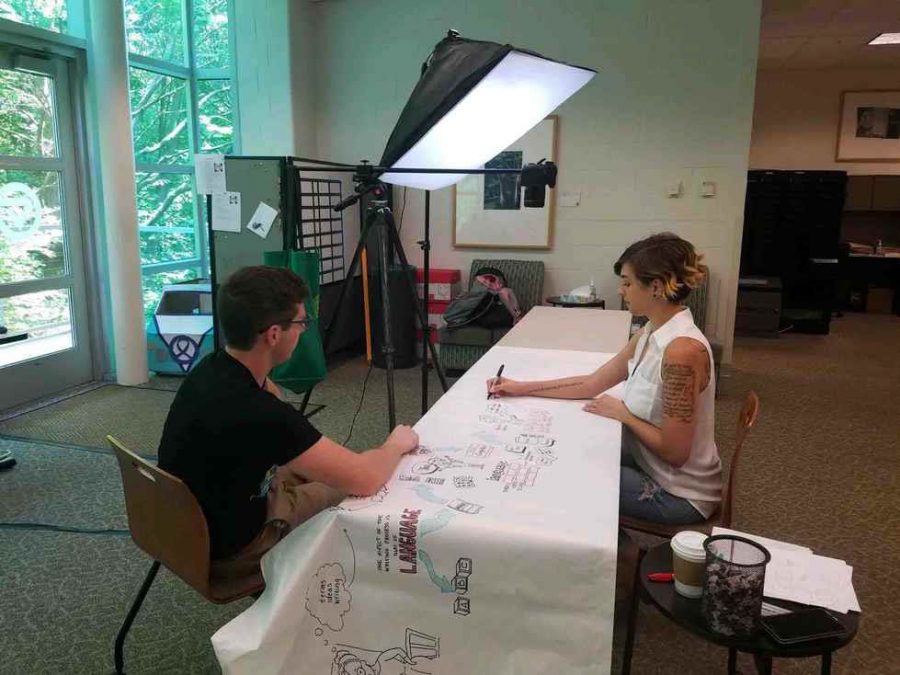Interactive Studio class plans to study “synchronous displacement”
Nov 9, 2020
Since most of the classes at Grand Valley State University have moved to either partially or entirely online, students and faculty have relied heavily on video conferencing software such as Zoom. In winter 2021, ART 394 Interactive Studio will focus on investigating questions that have arisen in the midst of this sudden shift in dependence on technology for synchronous interaction.
Interactive Studio is offered by the Department of Visual and Media Arts. The course fulfills an issues credit, therefore, students must be junior standing to enroll. While the course attracts many art majors, it is offered to all students without any prerequisites. Projects are primarily multimedia and technology-based, so traditional art skills are not required to succeed in this course.
Professor of Interactive Studio Sara Alsum Wassenaar said, “In a lot of the visual studies classes, having students from different majors across campus is a real attribute to the environment because of the diversity that it brings.”
Fifth-year visual studies student Calvin Garvey took Interactive Studio in winter 2018 and will be enrolling in the class for the second time in 2021. They said while they recommend the class to engineering students and coding, students should not feel intimidated by the coding aspects of the course.
Interactive Studio was in a unique position going into this year because the course curriculum did not have to change in order to fit some of the most relevant issues going on in the world today. This course has always addressed these issues, but the content has just become more relevant in the last year.
Paul Wittenbraker, head of the Visual Studies section of the Department of Visual and Media Arts, said that they focused on context during the development of certain courses in the department over a decade ago. This cushioned the transitions that the department has had to go through in the last year.
“What we’ve found interesting is that because these courses are designed to be responsive to site and context, and focus on the knowledge, skills, and attitudes necessary for such responsiveness, the challenges the pandemic brings are not as much about adjusting the course, but just a special case of what the courses always are doing,” said Wittenbraker.
Alsum-Wassenaar was inspired to make one of the themes of this year’s course “synchronous displacement” after observing technology’s role in bringing people together during the pandemic. While people are not able to gather as much as before, technology has made it possible to hold class, work and socialize synchronously.
“Bedrooms have replaced boardrooms while Zoom connects us all from anywhere to anywhere,” Alsum-Wassenaar said. “Space has become displaced.”
One of the projects addresses the concept of Zoom ice breakers. Ice breakers are typically meant to guide introductions, however, these social exercises look differently this school year. Alsum-Wassenaar said students will be asked to think about and create interactive tools that would facilitate collaboration in a zoom environment.
Students will also have a project centered around sound. Sara described the common zoom experience of multiple people talking at once as an “auditory symphony.” Students will be asked to gather sounds and ultimately create a piece of interactive art that will allow people to self layer them, resulting in a keyboard of captured sounds and conversations.
“Sound is a fun thing to play with and it’s not an art form that a lot of people have experience with so it’s definitely something that we’re going to explore in the class,” said Alsum-Wassenaar.
Alsum-Wassenaar said it’s important for students in Interactive Studio to enter the course with a willingness to experiment and develop new skill sets as they make them their own through their idea-driven projects. She said she hopes students will leave the class with a more complete understanding of what is going on in the moment they are currently living in. As students begin to grasp on to the concepts covered in the class, Alsum-Wassenaar encourages them to further their investigation by asking deeper and more complex questions.
“I think art has this unique ability to take a particular moment and kind of magnify its characteristics in a way that helps you to understand what it is that we’re dealing with,” said Alsum-Wassenaar.























